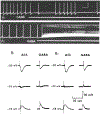GABA as a Neurotransmitter in Gastropod Molluscs
- PMID: 30933636
- PMCID: PMC7710352
- DOI: 10.1086/701377
GABA as a Neurotransmitter in Gastropod Molluscs
Abstract
The neurotransmitter gamma-aminobutyric acid (GABA) is widely distributed in the mammalian central nervous system, where it acts as a major mediator of synaptic inhibition. GABA also serves as a neurotransmitter in a range of invertebrate phyla, including arthropods, echinoderms, annelids, nematodes, and platyhelminthes. This article reviews evidence supporting the neurotransmitter role of GABA in gastropod molluscs, with an emphasis on its presence in identified neurons and well-characterized neural circuits. The collective findings indicate that GABAergic signaling participates in the selection and specification of motor programs, as well as the bilateral coordination of motor circuits. While relatively few in number, GABAergic neurons can influence neural circuits via inhibitory, excitatory, and modulatory synaptic actions. GABA's colocalization with peptidergic and classical neurotransmitters can broaden its integrative capacity. The functional properties of GABAergic neurons in simpler gastropod systems may provide insight into the role of this neurotransmitter phenotype in more complex brains.
Keywords: BCI, buccal-cerebral interneuron; CBC, cerebral-buccal connective; CBI, cerebral-buccal interneuron; CNS, central nervous system; CPG, central pattern generator; Cr-Aint, cerebral A interneuron; DA, dopamine; EPSP, excitatory postsynaptic potential; FCAP, feeding circuit activating peptide; GABA, gamma-aminobutyric acid; GABAli, GABA-like immunoreactivity; IPSP, inhibitory postsynaptic potential; PKC, protein kinase C.
Figures




References
-
- Alkon DL, Anderson MJ, Kuzirian AJ, Rogers DF, Fass DM, Collin C, Nelson TJ, Kapetanovic IM, and Matzel LD 1993. GABA-mediated synaptic interaction between the visual and vestibular pathways of Hermissenda. J. Neurochem 61: 556–566. - PubMed
-
- Arshavsky YI, Deliagina TG, Gamkrelidze GN, Orlovsky GN, Panchin YV, Popova LB, and Shupliakov OV 1993. Pharmacologically induced elements of the hunting and feeding behavior in the pteropod mollusk Clione limacina. I. Effects of GABA. J. Neurophysiol 69: 512–521. - PubMed
-
- Arshavsky YL, Gamkrelidze GN, Orlovsky GN, Panchin YV, and Popova LB 1991. Gamma-aminobutyric acid induces feeding behaviour in the marine mollusc, Clione limacina. NeuroReport 2: 169–172. - PubMed
-
- Beg AA, and Jorgensen EM 2003. EXP-1 is an excitatory GABA-gated cation channel. Nat. Neurosci 6: 1145–1152. - PubMed
Publication types
MeSH terms
Substances
Grants and funding
LinkOut - more resources
Full Text Sources
Miscellaneous

